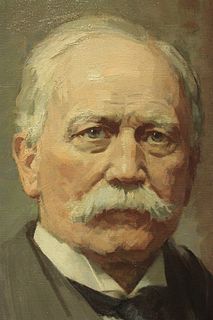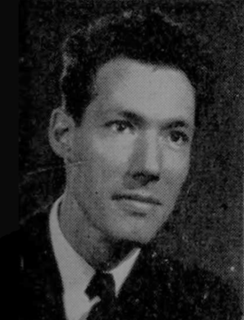
Sir Robert Rowand Anderson, was a Scottish Victorian architect. Anderson trained in the office of George Gilbert Scott in London before setting up his own practice in Edinburgh in 1860. During the 1860s his main work was small churches in the 'First Pointed' style that is characteristic of Scott's former assistants. By 1880 his practice was designing some of the most prestigious public and private buildings in Scotland.

Gillespie, Kidd & Coia were a Scottish architectural firm famous for their application of modernism in churches and universities, as well as at St Peter's Seminary in Cardross. Though founded in 1927, it is for their work in the post-war period that they are best known. The firm was wound up in 1987.

Alfred Charles Bossom, Baron Bossom FRIBA was an English architect active in the United States, and Conservative Party politician.

Howrey LLP was a global law firm that practiced antitrust, global litigation and intellectual property law. At its peak Howrey had more than 700 attorneys in 17 locations worldwide.
RMJM is one of the largest architecture & design networks in the world. Services include architecture, development management, engineering, interior design, landscape design, lead consultancy, master planning, product design, specialist advisory services, urban design. The network caters to a wide range of clients in sectors including mixed-use, education, healthcare, energy, residential, government and hospitality.

Massimiliano Fuksas is an Italian architect. He is the head of Studio Fuksas in partnership with his wife, Doriana Mandrelli Fuksas, with offices in Rome, Paris and Shenzhen.

Louis Emanuel Jean Guy de Savoie-Carignan de Soissons CVO RA FRIBA (1890–1962) was the younger son of Charles, the Count de Soissons. An architect, he was called for professional purposes Louis de Soissons.
Edward J. Schulte was an architect who designed a number of mid-twentieth-century churches notable for their blending of a modern idiom with traditional function. Inspired by an encounter with Ralph Adams Cram, he devoted himself to building church buildings, designing over 88. He served as president of the Cincinnati chapter of the American Institute of Architects.

Hart Wood (1880–1957) was an American architect who flourished during the "Golden Age" of Hawaiian architecture. He was one of the principal proponents of a distinctive "Hawaiian style" of architecture appropriate to the local environment and reflective of the cultural heritage of the islands. He was one of the three founders of the Honolulu Chapter of the American Institute of Architects, and the only one of its fourteen charter members to be elected a Fellow of the AIA. He served as territorial architect during World War II.

James Keys Wilson was a prominent architect in Cincinnati, Ohio. He studied with Charles A. Mountain in Philadelphia and then Martin E. Thompson and James Renwick in New York, interning at Renwick's firm. Wilson worked with William Walter at the Walter and Wilson firm, before establishing his own practice in Cincinnati. He became the most noted architect in the city. His Old Main Building for Bethany College and Plum Street Temple buildings are National Historic Landmarks. His work includes many Gothic Revival architecture buildings, while the synagogue is considered Moorish Revival and Byzantine Architecture.

James William Strutt was a Canadian architect. Practising between 1950 and 1999 and working primarily in the Ottawa area, Strutt is noted for his role in the development of modern architecture in Canada following World War II.
Malcomson and Higginbotham was an architectural firm started in the nineteenth century and based in Detroit, Michigan. A successor firm, Malcomson-Greimel and Associates, still exists in Rochester, Michigan as of 2010.

Anthony J. DePace (1892–1977) was an American architect who designed numerous Roman Catholic churches throughout the Northeastern United States area during the mid to late 20th century.

The Church of St. Dominic is a Roman Catholic parish church under the authority of the Roman Catholic Archdiocese of New York, located at 1739 Unionport Road, Van Nest, Bronx, New York City. The parish was established in 1927. The Romanesque Revival was built 1925 to the designs of Bronx-native architect Anthony J. DePace of the firm DePace & Juster. In May 2011, two of the three bells were removed in order to service the wooden supports which were waterlogged and had seepage problems. The goal is to replace the wooden supports and return the bells to their original location. The expected restoration cost of the bells is estimated at $30,000.
The Church of St. Theresa of the Infant Jesus is a Roman Catholic parish church under the authority of the Roman Catholic Archdiocese of New York, located at 2855 St. Theresa Avenue, Bronx, New York City. It was established in 1927.

Polak and Sullivan was an American architectural firm that was active between 1935 and 1975. The New Haven, Connecticut, based organization concentrated on work for Roman Catholic clients in Connecticut.

Michael O'Donohue (1835–1912) was an Irish-American builder and architect from Hartford, Connecticut who designed a number of ecclesiastical buildings in New England for both Roman Catholic and Jewish clients.
Mansell, Lewis & Fugate was an architectural firm established in 1955 by architects Thomas Norman Mansell, Richard Arnold Lewis, and Edwin Lindsay Fugate, as the direct successor to the firm, T. Norman Mansell, established in 1938. The firm was based at 300 E. Lancaster Avenue Wynnewood, Pennsylvania 19096 and practiced in Delaware, Delaware, Georgia, Kentucky, Maryland, Michigan, Minnesota, New Jersey, New York, North Carolina, Ohio, Pennsylvania, South Carolina, and Virginia. The firm often worked with Lutheran clients. The firm's work at Wittenberg University Chapel was awarded the excellence of design award by the Guild Religious Architecture in 1957. The firm continued in practice until 1969 when the partnership was dissolved.
Sir Thomas Edwin CooperRA FRIBA was an English architect. His work has been described as "essentially Classical, and sometimes powerfully Baroque."














